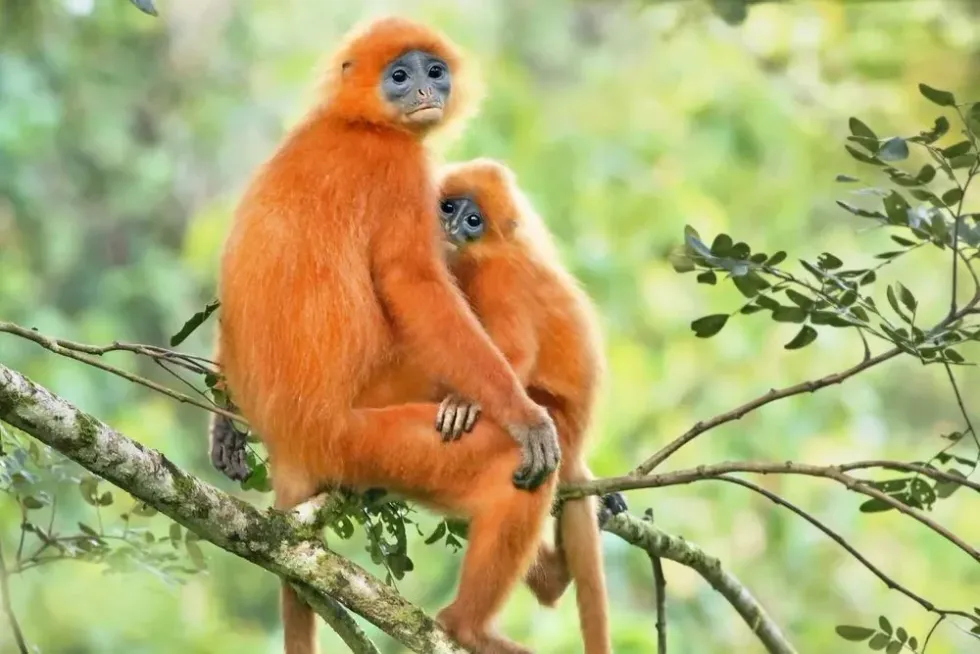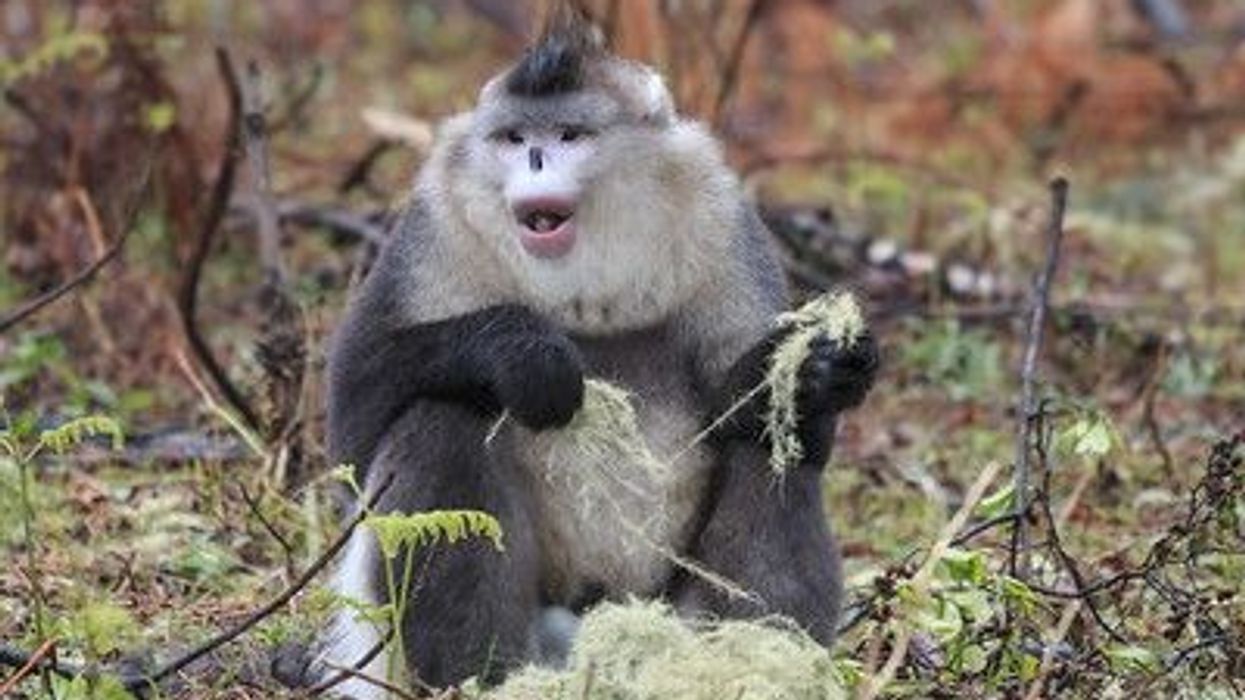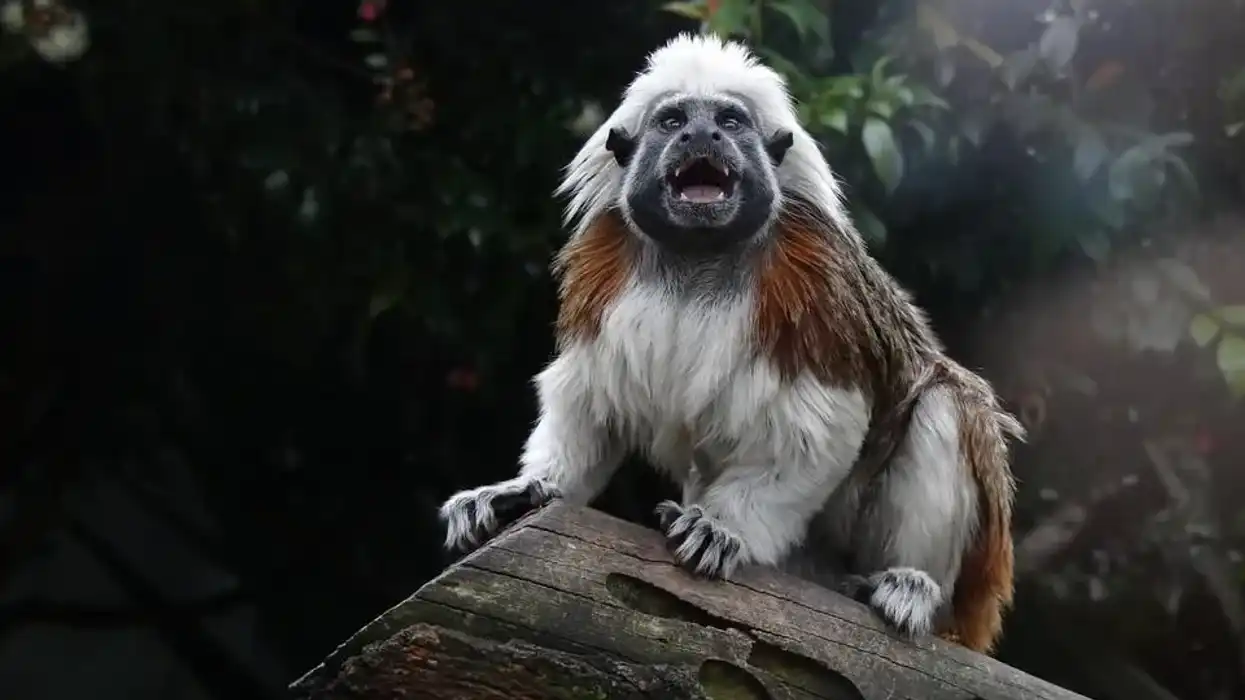Are you interested in knowing more about species like the macaque monkey? If yes, then you would surely like to learn about the maroon leaf monkey.
This species of primates belong to the leaf monkey group that's defined by its arboreal nature as the animals spend most of its time in the trees. The red leaf monkey is endemic to the island of Borneo present in Southeast Asia, and its mainly found in the Sabah region of Northern Borneo.
The monkey is mostly known for its auburn or reddish-orange hair that covers its body. Along with that, it also has a bluish-black face and big eyes.
Living in the trees, this species mostly consume young leaves along with flowers, fruits and seeds. During some months, these monkeys also consume termite soil which makes it a unique species.
These monkeys live in a group of 2-13 individuals and each group has one male. Unfortunately, this is a vulnerable species, and the numbers have been dwindling due to habitat loss and hunting. So, do keep reading to know more maroon leaf monkey facts.
If you like this article, also check out our pieces on macaque monkey and howler monkey.
Maroon Leaf Monkey Interesting Facts
What type of animal is a maroon leaf monkey?
The maroon leaf monkey is a species of monkey found primarily in forests of Borneo. This animal is known by the various names of red leaf monkey, red langur, and maroon langur. It's also classified as an Old World monkey.
What class of animal does a maroon leaf monkey belong to?
The maroon leaf monkey belongs to the class Mammalia just like other primates. It also belongs to the family Cercopithecidae that's shared by other langur monkeys.
How many maroon leaf monkeys are there in the world?
We don't know the exact population of this species. But, several studies show that the population of maroon leaf monkeys have been declining, which has given it the status of being Vulnerable throughout its natural habitat.
Where does a maroon leaf monkey live?
The red leaf monkey is a primate endemic to the Borneo islands in southeast Asia. Its home range also includes the forests of the Karimata island which lies nearby. The territory of this monkey includes both Indonesian and Malaysian Borneo. In Northern part of the island, the primate can mostly be seen in the Danum Valley of Sabah.
What is a maroon leaf monkeys’ habitat?
Some of the common habitats for the maroon leaf monkeys include primary and secondary lowland forests, and swamp forests. At times, it can also be seen in gardens nearby the usual forest habitat of an island mainly in search of food. This is an arboreal species, so monkeys mostly spend time on the trees eating or doing other activities.
Who does a maroon leaf monkey live with?
Like other primates, the red leaf monkeys also live in groups. A group usually contains 2-13 individuals, and most of them have a single male.
Males can be quite territorial, and when an intruder is nearby its territory, it will make loud noises and can even pick up a fight. A common behavior while eating during dawn, a group usually splits into two or more subgroups.
How long does a maroon leaf monkey live?
In its wild habitat, the maroon langur can live for around 20 years. However, in captivity, the primate can live for 25 years or more. Scientists also believe that the langur maroon lifespan is decreasing in the wild because of habitat destruction in its native island.
How do they reproduce?
These monkeys have a polygynous mating system, so a group usually contains a single male that mates with multiple females. Each female usually gives birth to one baby per breeding season.
The young males spend time with the group before it reaches adulthood, and then it proceeds to form its own group. And, reaching sexual maturity may take up to three years.
What is their conservation status?
The International Union for Conservation of Nature (IUCN) classifies the maroon leaf monkeys under the status of Vulnerable because of its low population range.
Maroon Leaf Monkey Fun Facts
What does the maroon leaf monkey look like?
The maroon leaf monkeys are named so because of the auburn or reddish-orange hair that covers its whole body. You will notice that the hair on its limbs and tail are darker than the rest of its body.
For leaping, the hindlegs of this species are slightly longer than the forelimbs. Apart from that, the monkeys have short faces that are blue to black.
The dark eyes are wide-set in the face and the jaw is rather deep. Compared to other primates, the thumb of these monkeys is much smaller.
How cute are they?
The maroon langur looks just as cute as the red-tailed monkey, especially because of its scarlet fur and its curious look.
How do they communicate?
The primary way of communication for a group of maroon langur is through calls. The dominant male is especially known for a loud call that is used to ward off intruders. Other than that, these monkeys also participate in tactile communication. Social grooming is also used by the group to maintain the bond amongst each other.
How big is a maroon leaf monkey?
The average head-body size range of the langur maroon is around 16-22 in (40.6-55.8 cm). These monkeys also have a long tail of around 26-29 in (66-73.6 cm). In comparison, the colobus monkey has an average body size range of up to 30 in (76.2 cm).
How fast can a maroon leaf monkey move?
We don't know the exact speed of the red leaf monkey, but you can find it slowly moving between the trees of a forest usually on all four limbs.
How much does a maroon leaf monkey weigh?
The average weight of the maroon leaf monkeys is around 13-15 lb (5.9-6.8 kg).
What are the male and female names of the species?
There are no separate names for males and females of the maroon langur species.
What would you call a baby maroon leaf monkey?
A baby maroon or red leaf monkey is known as an infant.
What do they eat?
As a herbivorous species, the maroon leaf monkey diet consists of young leaves, seeds, fruits, and flowers that naturally grow in the forests and its native habitat. Just like other leaf monkey species, the maroon langurs have sacculated stomachs so the diet heavily depends on leaves collected from trees.
One of the interesting parts of the diet of the maroon leaf monkeys is the intake of termite clay and soil for upping the intake of minerals.
First, the monkey would get rid of the soil on top of the termite hill and then start feeding on the freshly exposed soil. Scientists also believe that feeding on the soil gives relief from acidosis.
In Northern Borneo, during the months from June to September, the maroon langur is known for taking seeds as the primary food and it can be up to 90% of its whole diet. Seeds are supposed to be a protein-rich food, compared to the usual leaves and fruits.
These monkeys are mainly arboreal in nature, so you can find it moving between trees rather than on the ground.
Are they dangerous?
Not really! The maroon langur can definitely be a dominant species in the forests and be aggressive to protect its group, but it isn't threatening for human beings.
Would they make a good pet?
No, as a vulnerable species, the maroon leaf monkeys aren't supposed to be pets. And, having it as a pet can lead to legal complications, because it's protected as a part of conservation efforts.
Did you know...
Scientists believe that the common behavior of this species to have only one male in the group is because of the reduced threat of eagles. However, the other maroon leaf monkey predators include dogs, cats, and even humans in huge numbers.
The maroon leaf monkey's defense
The foremost way of defense for the maroon leaf monkey is through making a loud call made by the male member. Along with letting its family know about the threat, the call also makes it clear to the intruder that the area belongs to someone else.
As most of these monkeys have a uni-male social system, this works as a great maroon leaf monkey weapons and defense. At times, this species of monkeys will also pick up a fight with intruders.
Here at Kidadl, we have carefully created lots of interesting family-friendly animal facts for everyone to discover! For more relatable content, check out these woolly monkey facts and howler monkey facts for kids.
You can even occupy yourself at home by coloring in one of our free printable blue monkey coloring pages.
Second image by Mike Prince from Bangalore, India.










